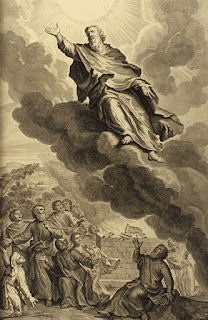Growing up in my small church I was given a map, a mimeographed map, of the afterlife. The issue the map was solving was the timing of Judgment Day. Specifically, where are the dead as we all await the final judgment?
There are some faith traditions, though few, who say the dead are actually dead. The dead are "nowhere," or at least in a state of unconscious "sleep." But for traditions who believe that the soul survives bodily death and retains a sense of selfhood, where does that soul go?
Again, the issue concerns Judgment Day. Souls can't go to heaven or hell before the Judgment, so they have to go to some sort of holding area to await the Judgment. This is what my map described. The dead went to a holding place called Hades or Tartarus (not Hell, that's after the judgment) to await the future Judgment. On Judgment Day, the dead would be raised from Hades/Tartarus to be judged alongside the living.
The map I was given wasn't crazy. Tartarus is described in the New Testament as a place where fallen angels are being held to await Judgment Day:
For if God didn’t spare the angels who sinned but threw them down into Tartarus and delivered them to be kept in chains of darkness until judgment. (2 Peter 2.4)Now I want to remind you, though you know all these things: The Lord first saved a people out of Egypt and later destroyed those who did not believe; and He has kept, with eternal chains in darkness for the judgment of the great day, the angels who did not keep their own position but deserted their proper dwelling. (Jude 5-6)Christ also suffered once for sins, the righteous for the unrighteous, to bring you to God. He was put to death in the body but made alive in the Spirit. After being made alive, he went and made proclamation to the imprisoned spirits— to those who were disobedient long ago. (1 Peter 3.18-20)
“The time came when the beggar died and the angels carried him to Abraham’s side. The rich man also died and was buried. In Hades, where he was in torment, he looked up and saw Abraham far away, with Lazarus by his side. So he called to him, ‘Father Abraham, have pity on me and send Lazarus to dip the tip of his finger in water and cool my tongue, because I am in agony in this fire.’
“But Abraham replied, ‘Son, remember that in your lifetime you received your good things, while Lazarus received bad things, but now he is comforted here and you are in agony. And besides all this, between us and you a great chasm has been set in place, so that those who want to go from here to you cannot, nor can anyone cross over from there to us.’" (Luke 16.22-26)
"These hollow places are intended that the spirits of the souls of the dead might be gathered into them. For this very purpose they were created, that here the souls of all human beings should be gathered. And look, these are the pits for the place of their confinement. Thus they were made until the day on which they will be judged, and until the time of the day of the end of the great judgment that will be exacted from them." (1 Enoch 22.3-4)
Then I asked about all the hollow places, why they were separated one from the other. And [Raphael] answered me and said, "These three were made that the spirits of the dead might be separated. And this has been separated for the spirits of the righteous, where the bright fountain of water is." (1 Enoch 22.8-9).


